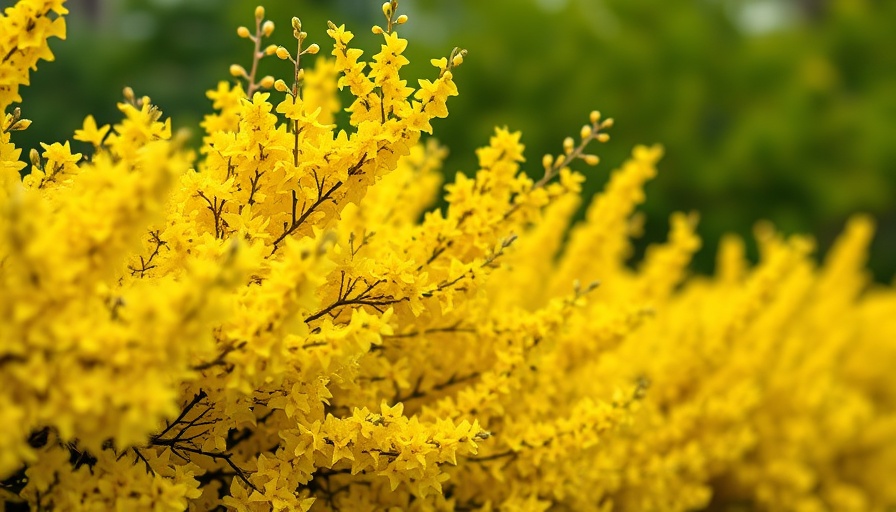
Unleashing the Beauty of Forsythia: A Garden Staple
For many gardeners, living in USDA Hardiness Zones 5 to 8 presents an opportunity to incorporate bright-yellow blossoming shrubs into their landscape. Forsythia, known for its stunning spring display, is not just a decorative plant but a versatile landscape asset. Offering features such as a natural privacy screen or a feature hedge, these woody shrubs serve cultivating beauty and function in equal measure.
The Right Variety for Your Garden
Choosing the right variety of forsythia is essential for achieving the desired design and maintenance level. With 11 species available, consider the growth habits and attributes of each to select the best option for your garden. For instance:
- F. suspensa: 6-10 feet tall with a weeping growth habit; can double as a vine or ground cover.
- F. viridissima: A compact upright shrub that remains around 10 feet tall.
- F. x intermedia: This hybrid features arching and upright branches, typically reaching 8 to 10 feet.
You may also want to explore specific cultivars like F. intermedia ‘Spectabilis’, celebrated for its prolific blooms, though it may require more pruning to maintain density.
Define Your Style: Formal or Informal
Engage your creativity by deciding whether you want to cultivate a formal hedge with a tidy, manicured appearance or an informal, free-flowing look. Each style offers unique benefits:
- Formal: Creates structured boundaries and is perfect for traditional garden designs.
- Informal: Invites a natural, relaxed aesthetic that complements wildflower gardens.
Your choice of style may influence the amount of pruning and care required throughout the growing season.
Planting and Growing: A Step-By-Step Guide
Successful cultivation begins with proper planting. Start by finding a sunny location, as forsythia thrives best in full sunlight. When planting, adhere to these tips:
- Space your plants adequately to allow for their vigorous growth; 3-5 feet apart is typically advisable.
- Use well-draining soil enriched with organic matter—this will boost growth and flowering.
- Water deeply at the time of planting and ensure regular irrigation, particularly during dry spells.
Implementing these steps paves the way for robust growth and healthy blooms.
Sunlight: Essential for Optimal Growth
Consistent sunlight is vital for forsythia plants. The more sun they receive, the more vibrant and abundant their yellow flowers become. Ensure your selected site offers at least six hours of direct sunlight each day. If your forsythia is struggling, consider relocating it to a sunnier spot or trimming nearby foliage to reduce shade.
Pruning: The Key to Maintaining Shape and Health
Regular pruning will help maintain your hedge's aesthetic and encourage new growth. Here’s how to approach it:
- Prune in late spring after blooming to shape the hedge and encourage denser foliage.
- Perform periodic deep pruning every few years to remove old wood from the base of the plant, allowing younger branches to flourish.
- Always aim to maintain an open center in the shrub to improve air circulation and discourage diseases.
Periodic Deep Pruning: Guiding Growth and Health
Every three years or so, deep pruning can give forsythia a new lease on life. This process includes cutting back two-thirds of the plant, which fosters strong growth and refreshes the hedge. While it may seem drastic, it assures that your forsythia remains vigorous with abundant blooms.
The Beauty of Forsythia in Your Landscape
With these tips in mind, you’re ready to create an eye-catching forsythia hedge that could serve as a dynamic backdrop for colorful blooms or a privacy accent in your garden. Remember that with the right care and attention, these shrubs can flourish for years, adding beauty and function to any landscape.
Why not start your forsythia journey today and explore the endless possibilities! Whether you are designing a new garden or refreshing an old one, these vibrant blooms will celebrate the arrival of spring and offer you a rewarding gardening experience.
 Add Row
Add Row  Add
Add 




Write A Comment